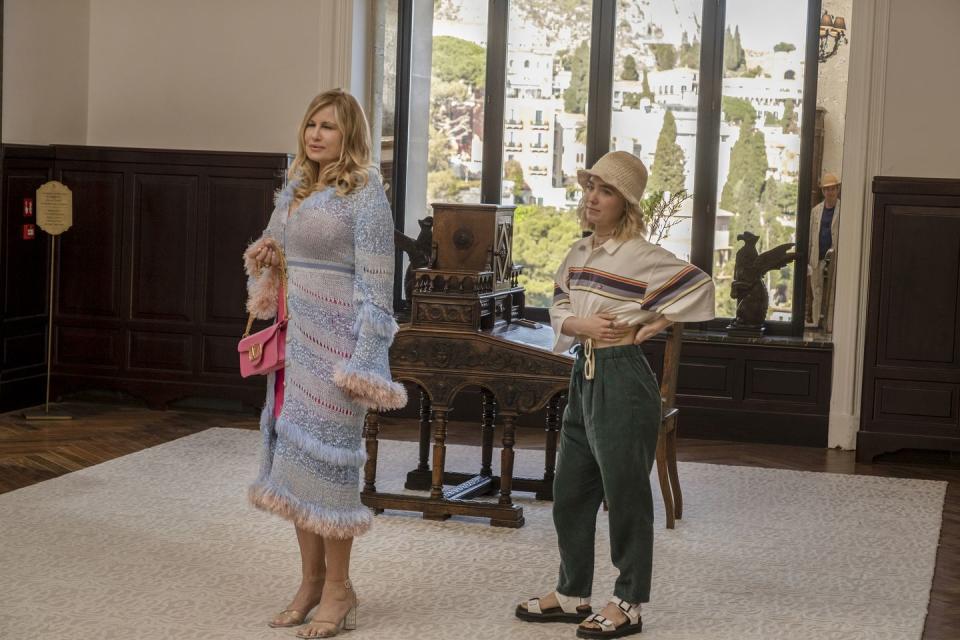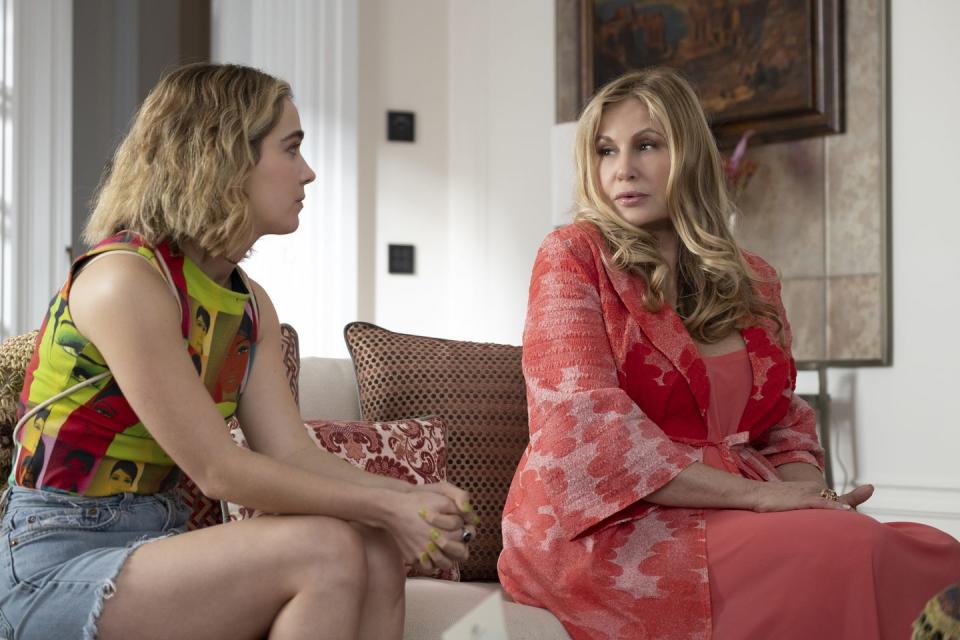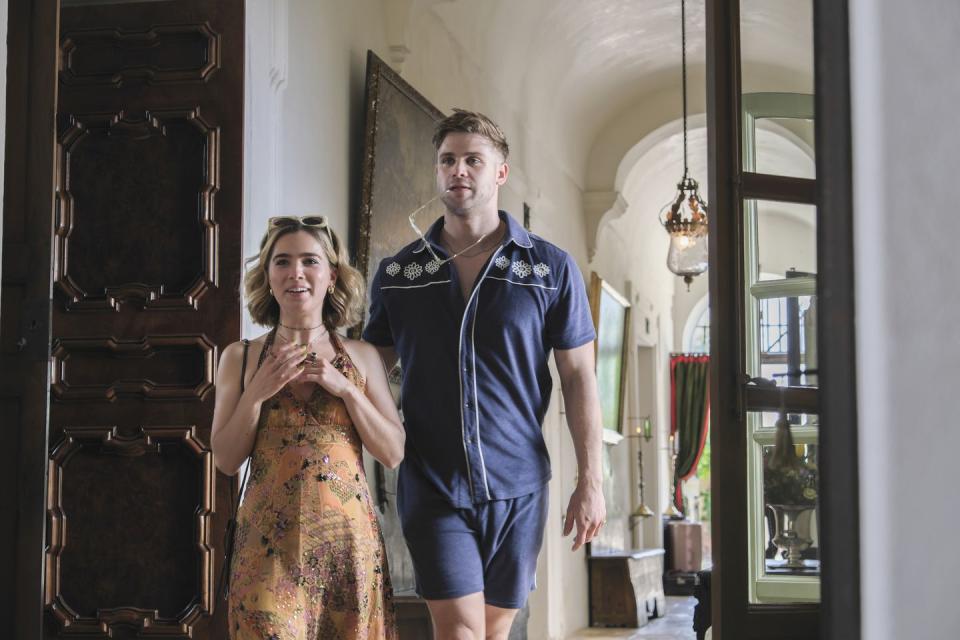'The White Lotus's' Portia Is TV’s Best-Dressed Character

- Oops!Something went wrong.Please try again later.
Alex Bovaird, the costume designer for The White Lotus, is one of the best working on television today. I still think about that blue and white striped polo that Shane (Jake Lacy) wore in the opening scene of the first season. You see the polo, the way it’s just a little too snug and maybe looks like something his mom bought him for Christmas, and you get it right away, before he even opens his arrogant little mouth: God, that guy is an asshole.
Bovaird’s costumes are documentarian, anthropological. They are not fantasy the way a Pat Field costume is, or aspirational the way that Sandy Powell’s works of art for Martin Scorsese’s period films are. They don’t even take a seed of reality, as Heidi Bivens does on Euphoria (or Mona May did with Clueless), and expand it into a fantastical whole world. Instead, Bovaird’s costumes are alarmingly precise, offering that same pit-in-your-stomach feeling that show creator Mike White’s dialogue elicits. When Daphne and Cameron, a thirty-something wealthy couple showing their newly rich friends Harper and Ethan how the other half lives, struggle to remember whether or not they’ve voted, it occurred to me that I might describe them to friends as such: “They dress like people who are so eager to disengage with world events that they can’t remember in these politically manic times whether or not they’ve voted!” In other words: put together but not stylish in any exceptional way. He’s grabbing a little Casablanca silk blouse from Mr. Porter to look the part for their Sicilian vacation, and maybe he has a fancy watch; she, on the other hand, ordered everything in the Resort Vibes edit on Net-a-Porter two weeks ago.
Portia (Haley Lu Richardson), the Gen Z assistant to White Lotus’s pseudo-ingenue Tanya (Jennifer Coolidge), dresses like she has the Depop doldrums. She wears sweatpants yanked too high with a baggy Tommy Hilfiger cropped rugby that also has a bungee around the waist (one of those wacko commercial garments that hopes to hit nine trends at once). A burning coil of morality means she doesn’t want to shop at Shein like some of her friends do, so she’s cobbled together stuff from online secondhand sites and a few Instagram thrift stores. Portia does not dress like a character from Euphoria; she dresses like a lost young woman who watches Euphoria. Ouch.

Her costumes are probably Bovaird’s best creation, this season or last. (Perhaps Nicole Mossbacher, the wealthy girl boss tech executive with her precisely edited but somehow quickly acquired vacation wardrobe in season one, comes in second.) What Bovaird has gotten so right about Portia is that she is not a devotee who lives for fashion but is a woman from a generation for whom style, or the approximation of it, is exercised like a god-given right. Or maybe it’s even more fundamental than that: colors, prints, and a kind of postmodern bonanza of thinly understood cinematic, TV, and music references are like water and air, the foundation of any wardrobe.
Portia’s clothes epitomize her young person’s lament: she is desperate to date anyone, she says at one point, “who is totally ignorant of the discourse” because she’s so “sick of TikTok and Bumble.” And yet, as her slapdash wardrobe tells us, it’s impossible for her to log off. Whether that’s a personal problem or a generational one is a question only she can answer.
Mia and Lucia, two sex workers who take advantage of the sex-addicted Hollywood hot shot played by Michael Imperioli, lust after sequined minidresses and Alessandro Michele-ified Gucci rompers that belie that classic belief that owning a certain dress or pair of shoes will change your life. Even Harper, the stick-in-the-mud lawyer played by Aubrey Plaza, seems to have a relatable appreciation for clothes. She may feel ambivalent about her and her husband’s newfound wealth, but she obviously made a few purchases before the trip that suggest she spent her twenties scrolling through influencers on Instagram even if she might roll her eyes at them. (That brand that makes her white dress has a note on their site that “Our mission is to deliver financial empowerment to disadvantaged women.” One can see how a woman like Harper, newly guilty about her financial security, might find that an appealing quality in a cut-out micro-mini dress.)
Portia, on the other hand, is ambiently aware of fashion. What seemed extreme not so long ago is now just basic. She wears a ludicrous sweater vest with swans swimming on it with distressed cut-off jean shorts like anyone else wears a T-shirt and baseball cap. Though her clothes look so chaotic that they suggest cultivated taste and dedication, she actually has no time to care about how clothes cling to her body, nor does she really care; she’s much more interested in adorning herself with piercings, her nails with acid green polish, her hair with bleach (well, when she feels like it. A little root is cool). When she wears a shirt printed with cartoon images of women that looks like a Wet Seal knockoff three or four years removed from Gianni Versace’s groundbreaking Spring 1991 collection that put Warhol screenprints on couture gown, one doesn’t get the sense that she’s looking to school us on the spirit of Gianni. She’s merely huffing the omnipresent and vague vibes of nostalgia. It isn’t that Bovaird is suggesting Gen-Zers are unstylish; in fact, she dresses Portia to suggest that they are almost too stylish. (And let’s be clear: some of the most stylish people in the world belong to Gen Z.) Instead, she tracks through Portia how clothes that seems chaotic and inscrutable to anyone older than 28 are perhaps reflecting a sense of chaos and confusion within.

All more pitch perfect: no one says a thing about her clothes. Neither her gently woke suitor nor her hilariously distasteful one compliment her exposed abs or her beautiful hair; you don’t even hear the older men make comments about her appearance. The one hint we have (at least so far) as to what others make of her clothing is in the latest episode, when Tanya tells her they’re going to Palermo on their new pal Quentin’s yacht and she’ll “need to bring some cute things. Do you have some cute things?” And when Portia says yes, Tanya replied with brilliant Coolidge rudeness, “You sure?” In the face of this sartorial generational divide, older generations increasingly find it best to just shut up. But sometimes, a boomer can’t help herself.
The joke only grows more perverse when we see what Portia categorizes as “cute things,” like a stretchy blue tube top and matching pair of bellbottoms she wears on a date with Leo. Probably her TikTok feed served her someone dissecting the Spice Girls aesthetic, double top-knots and all. (I loved that, in one moment, we see her turn her face away from the camera, revealing the amount of snap clips it took to secure her hair like that. Like: “the limits of my own hair length be damned! I’m doing this Spice Girls style!”)

Only a few years ago, a high-powered boss might demand that her assistant wear a specific uniform or at least adhere to a dress code; now, of course, even the most powerful people know you can’t really tell people what to wear. (Hence: crop tops in the office.) The lack of clothing direction from Tanya adds to the perplexity of her job; usually, mandates like “wear a blazer” or “always wear black” are a major way that a new hire helps navigate their boss’s needs and priorities. Without such suggestions, it’s unclear to Portia what she’s even being paid to do. Is she Tanya’s friend? Her therapist? Her sidekick? If her job is simply to read Vanity Fair in the dark while her boss sleeps nearby, you can’t blame her for dressing like an extra in a Disney Channel music video from 2003.

What makes a costume good? I thought of this also in my (admittedly very Tárdy!) viewing of Tár, whose costumes the internet has been salivating over since its release nearly two months ago. I was surprised at the attention the clothes got given how much understated brands like The Row and Yohji Yamamoto are used; The Row, in particular, is often criticized online for looking too boring or quiet. What’s striking about their appearance in Tár is that you see how special, how stylish, how profound the clothes are. Seeing the clothes moving in the world this character inhabits—in the driver’s seat of a Porsche, wandering around a gorgeous Brutalist apartment, or lecturing obnoxiously at a young and naive student—makes us understand the clothes more, and in turn, the character wearing them. When I saw Portia get on that yacht in the printed handkerchief dress with the sparkles and a pair of Converse sneakers, I could just picture her typing into Poshmark “vintage Cavalli,” and then maybe, “vintage 90s mall dress.” (It’s actually a newer dress, from the brand French Connection.) Whether Bovaird thought of things with that level of detail doesn’t really matter. If a costume designer suggests to us that much of a character’s interior life offscreen through the work of fabric and print alone—that’s an incredible achievement.
You Might Also Like

